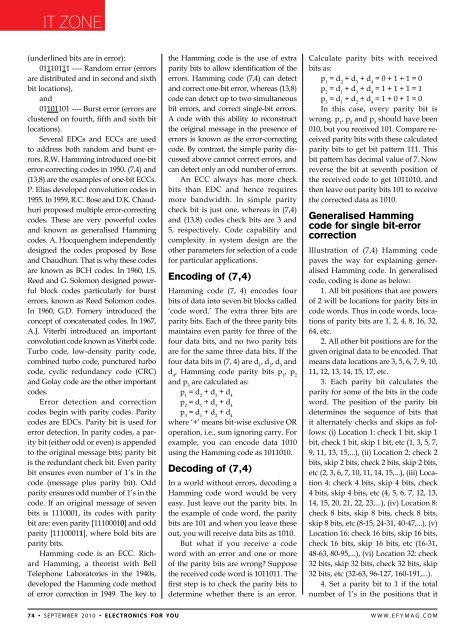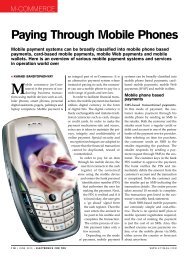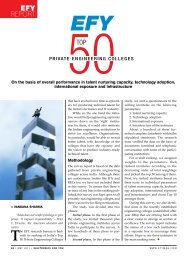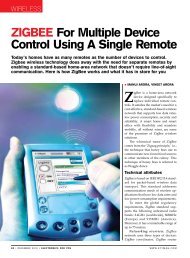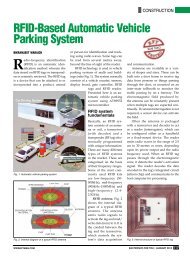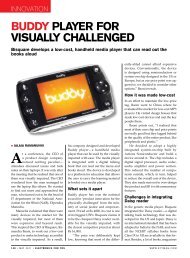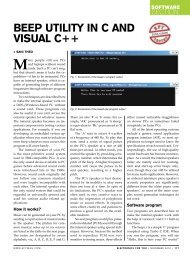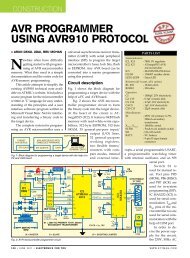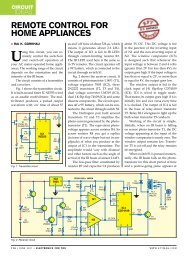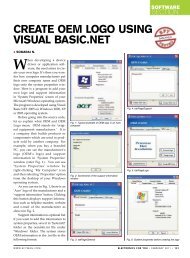How to EncodE and dEcodE InformatIon
How to EncodE and dEcodE InformatIon
How to EncodE and dEcodE InformatIon
Create successful ePaper yourself
Turn your PDF publications into a flip-book with our unique Google optimized e-Paper software.
IT Zone<br />
(underlined bits are in error):<br />
01110111 ---- R<strong>and</strong>om error (errors<br />
are distributed <strong>and</strong> in second <strong>and</strong> sixth<br />
bit locations),<br />
<strong>and</strong><br />
01101101 ---- Burst error (errors are<br />
clustered on fourth, fifth <strong>and</strong> sixth bit<br />
locations).<br />
Several EDCs <strong>and</strong> ECCs are used<br />
<strong>to</strong> address both r<strong>and</strong>om <strong>and</strong> burst errors.<br />
R.W. Hamming introduced one-bit<br />
error-correcting codes in 1950. (7,4) <strong>and</strong><br />
(13,8) are the examples of one-bit ECCs.<br />
P. Elias developed convolution codes in<br />
1955. In 1959, R.C. Bose <strong>and</strong> D.K. Chaudhuri<br />
proposed multiple error-correcting<br />
codes. These are very powerful codes<br />
<strong>and</strong> known as generalised Hamming<br />
codes. A. Hocquenghem independently<br />
designed the codes proposed by Bose<br />
<strong>and</strong> Chaudhuri. That is why these codes<br />
are known as BCH codes. In 1960, I.S.<br />
Reed <strong>and</strong> G. Solomon designed powerful<br />
block codes particularly for burst<br />
errors, known as Reed Solomon codes.<br />
In 1960, G.D. Fornery introduced the<br />
concept of concatenated codes. In 1967,<br />
A.J. Viterbi introduced an important<br />
convolution code known as Viterbi code.<br />
Turbo code, low-density parity code,<br />
combined turbo code, punctured turbo<br />
code, cyclic redundancy code (CRC)<br />
<strong>and</strong> Golay code are the other important<br />
codes.<br />
Error detection <strong>and</strong> correction<br />
codes begin with parity codes. Parity<br />
codes are EDCs. Parity bit is used for<br />
error detection. In parity codes, a parity<br />
bit (either odd or even) is appended<br />
<strong>to</strong> the original message bits; parity bit<br />
is the redundant check bit. Even parity<br />
bit ensures even number of 1’s in the<br />
code (message plus parity bit). Odd<br />
parity ensures odd number of 1’s in the<br />
code. If an original message of seven<br />
bits is 1110001, its codes with parity<br />
bit are: even parity [11100010] <strong>and</strong> odd<br />
parity [11100011], where bold bits are<br />
parity bits.<br />
Hamming code is an ECC. Richard<br />
Hamming, a theorist with Bell<br />
Telephone Labora<strong>to</strong>ries in the 1940s,<br />
developed the Hamming code method<br />
of error correction in 1949. The key <strong>to</strong><br />
the Hamming code is the use of extra<br />
parity bits <strong>to</strong> allow identification of the<br />
errors. Hamming code (7,4) can detect<br />
<strong>and</strong> correct one-bit error, whereas (13,8)<br />
code can detect up <strong>to</strong> two simultaneous<br />
bit errors, <strong>and</strong> correct single-bit errors.<br />
A code with this ability <strong>to</strong> reconstruct<br />
the original message in the presence of<br />
errors is known as the error-correcting<br />
code. By contrast, the simple parity discussed<br />
above cannot correct errors, <strong>and</strong><br />
can detect only an odd number of errors.<br />
An ECC always has more check<br />
bits than EDC <strong>and</strong> hence requires<br />
more b<strong>and</strong>width. In simple parity<br />
check bit is just one, whereas in (7,4)<br />
<strong>and</strong> (13,8) codes check bits are 3 <strong>and</strong><br />
5, respectively. Code capability <strong>and</strong><br />
complexity in system design are the<br />
other parameters for selection of a code<br />
for particular applications.<br />
Encoding of (7,4)<br />
Hamming code (7, 4) encodes four<br />
bits of data in<strong>to</strong> seven bit blocks called<br />
‘code word.’ The extra three bits are<br />
parity bits. Each of the three parity bits<br />
maintains even parity for three of the<br />
four data bits, <strong>and</strong> no two parity bits<br />
are for the same three data bits. If the<br />
four data bits in (7, 4) are d 1<br />
, d 2<br />
, d 3<br />
<strong>and</strong><br />
d 4<br />
, Hamming code parity bits p 1<br />
, p 2<br />
<strong>and</strong> p 3<br />
are calculated as:<br />
p 1<br />
= d 2<br />
+ d 3<br />
+ d 4<br />
p 2<br />
= d 1<br />
+ d 3<br />
+ d 4<br />
p 3<br />
= d 1<br />
+ d 2<br />
+ d 4<br />
where ‘+’ means bit-wise exclusive OR<br />
operation, i.e., sum ignoring carry. For<br />
example, you can encode data 1010<br />
using the Hamming code as 1011010.<br />
Decoding of (7,4)<br />
In a world without errors, decoding a<br />
Hamming code word would be very<br />
easy. Just leave out the parity bits. In<br />
the example of code word, the parity<br />
bits are 101 <strong>and</strong> when you leave these<br />
out, you will receive data bits as 1010.<br />
But what if you receive a code<br />
word with an error <strong>and</strong> one or more<br />
of the parity bits are wrong? Suppose<br />
the received code word is 1011011. The<br />
first step is <strong>to</strong> check the parity bits <strong>to</strong><br />
determine whether there is an error.<br />
Calculate parity bits with received<br />
bits as:<br />
p 1<br />
= d 2<br />
+ d 3<br />
+ d 4<br />
= 0 + 1 + 1 = 0<br />
p 2<br />
= d 1<br />
+ d 3<br />
+ d 4<br />
= 1 + 1 + 1 = 1<br />
p 3<br />
= d 1<br />
+ d 2<br />
+ d 4<br />
= 1 + 0 + 1 = 0<br />
In this case, every parity bit is<br />
wrong. p 1<br />
, p 2<br />
<strong>and</strong> p 3<br />
should have been<br />
010, but you received 101. Compare received<br />
parity bits with these calculated<br />
parity bits <strong>to</strong> get bit pattern 111. This<br />
bit pattern has decimal value of 7. Now<br />
reverse the bit at seventh position of<br />
the received code <strong>to</strong> get 1011010, <strong>and</strong><br />
then leave out parity bits 101 <strong>to</strong> receive<br />
the corrected data as 1010.<br />
Generalised Hamming<br />
code for single bit-error<br />
correction<br />
Illustration of (7,4) Hamming code<br />
paves the way for explaining generalised<br />
Hamming code. In generalised<br />
code, coding is done as below:<br />
1. All bit positions that are powers<br />
of 2 will be locations for parity bits in<br />
code words. Thus in code words, locations<br />
of parity bits are 1, 2, 4, 8, 16, 32,<br />
64, etc.<br />
2. All other bit positions are for the<br />
given original data <strong>to</strong> be encoded. That<br />
means data locations are 3, 5, 6, 7, 9, 10,<br />
11, 12, 13, 14, 15, 17, etc.<br />
3. Each parity bit calculates the<br />
parity for some of the bits in the code<br />
word. The position of the parity bit<br />
determines the sequence of bits that<br />
it alternately checks <strong>and</strong> skips as follows:<br />
(i) Location 1: check 1 bit, skip 1<br />
bit, check 1 bit, skip 1 bit, etc (1, 3, 5, 7,<br />
9, 11, 13, 15,...), (ii) Location 2: check 2<br />
bits, skip 2 bits, check 2 bits, skip 2 bits,<br />
etc (2, 3, 6, 7, 10, 11, 14, 15,...), (iii) Location<br />
4: check 4 bits, skip 4 bits, check<br />
4 bits, skip 4 bits, etc (4, 5, 6, 7, 12, 13,<br />
14, 15, 20, 21, 22, 23,...), (iv) Location 8:<br />
check 8 bits, skip 8 bits, check 8 bits,<br />
skip 8 bits, etc (8-15, 24-31, 40-47,...), (v)<br />
Location 16: check 16 bits, skip 16 bits,<br />
check 16 bits, skip 16 bits, etc (16-31,<br />
48-63, 80-95,...), (vi) Location 32: check<br />
32 bits, skip 32 bits, check 32 bits, skip<br />
32 bits, etc (32-63, 96-127, 160-191,...).<br />
4. Set a parity bit <strong>to</strong> 1 if the <strong>to</strong>tal<br />
number of 1’s in the positions that it<br />
74 • september 2010 • electronics for you www.efymag.com


